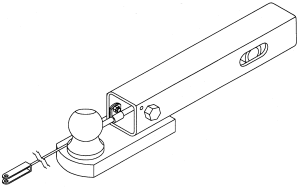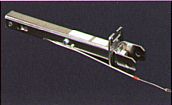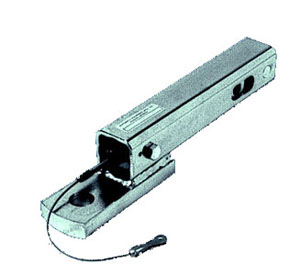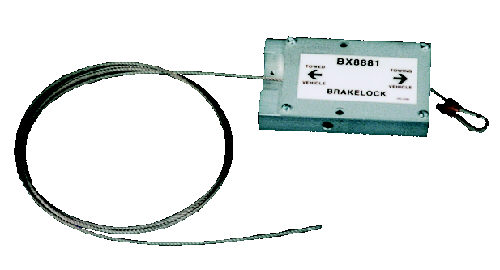 |
 Let us hook you up PO Box 540907 - Omaha, NE 68154 |
. |

| Available AutoStop Models | |
 |
|
| BX88100 Universal Mount for any receiver-mount tow bar | BX8893 for Aladdin & Aventa II tow bars |
 |
 |
| BX8894 for standard ball mount tow bars | BX8881 BrakeLock |
Also be sure to check out our FAQ about Dinghy Braking, which is a more general source of information on the subject of RV braking systems.
Why do I need a braking system?
If you've been paying attention to the RV industry news in recent months, you realize that dinghy brakes are a hot item. Especially in British Columbia, where the Canadian government is enforcing strict limitations on towing weights. New Towing Regulations for British Columbia are making Americans nervous as well, and RV'ers all around the country are moving fast to find out which braking system is ideal for them. The main concern for most folks is safety. Questions you can ask yourself are:
- "Do I have enough braking power in normal braking situations?"
- "Do I have enough braking power in emergency braking situations?"
- "Are my RV's brakes getting spongy and hot during normal driving conditions?"
- "Are my RV's brakes getting spongy and hot in more difficult driving conditions?"
Chassis Manufactures and Braking
Chevrolet literature states any trailer over 1,000 pounds loaded must have its own adequate brakes. Ford literature states that a separate functional brake system be used on any tow vehicle. Ford does not state a weight, but notes that most states require brakes on trailers over 1,500 pounds. Other chassis manufacturers have similar limits. Please check with the manufacturer of your chassis before towing. If a warranty issue concerning braking is raised on your chassis and you are outside their guidelines, be sure it will be used against you.
Braking system considerations
There are several different braking systems on the market today, ranging in price from less than $500.00 (the AutoStop by Blue Ox) up to well over $1000.00 plus installation. Before purchasing a braking system, be sure to find out if the product will affect the manufacturers original brake warranty. Some braking systems tie into the master cylinder and hydraulic lines, take several hours to be installed by an expert mechanic, and require modifications to either or both the RV's and the towed vehicle's brakes.
Hassle Free Braking System? The AutoStop by Blue Ox is the answer.
The AutoStop system is one of the few braking systems on the market that doesn't affect the integrity of the existing braking system on the RV or the towed vehicle. The AutoStop system converts the towed vehicle's weight into stopping power by applying it's own brakes with a cable and pulley system. This simple yet effective system requires only one small modification to your towed vehicle...a tiny hole drilled in the floor board of your towed vehicle behind the brake pedal to feed the cable through. The AutoStop will work with ABS and power brakes. The AutoStop is easily installed by most "backyard mechanics" in a few short hours, and is easy to maintain. Best of all, the AutoStop is universal and will work with any any vehicle. You can even use the AutoStop with more than one vehicle, by installing the "towed vehicle cable" in both towed vehicles.
How does the AutoStop attach to the tow bar and towed vehicle?
The standard AutoStop assembly is a custom ball mount that mounts into any standard 2" square receiver hitch. The AutoStop for RV mounted tow bars such as the Aventa, Aventa II, Aladdin, and KarBar is a special receiver connector that mounts to the tow bar swivel joint, replacing the original hollow receiver connector the comes attached to the original tow bar unit.
Exactly how does the AutoStop function?
The AutoStop functions on the basic surge break principle.
- Towed vehicle produces forward momentum and pushes against the AutoStop
- The AutoStop assembly recedes into the hitch (up to 1 3/4 inch)
- The pulley and cable system goes to work by shortening the cable
- The brake pedal on the towed vehicle is depressed (up to about 5 inches of 'pull')
- Once the forward momentum of the towed vehicle has ceased, the AutoStop returns to its original position.
The intricate inside of the AutoStop assembly is comprised of a shock absorber, a series of pulleys, and a cable which is wrapped around the pulleys. There is a second housed cable which runs from the connection point between the RV and the towed vehicle's brake pedal. A pin connects these two cables so that you can easily disconnect the AutoStop when you reach your destination. You determine when the cars brakes will activate by adjusting the preload compression of the power spring. AutoStop does not invade the cars or motorhomes brake system in any way. The adjustable preload and power return is easily modified but still proportional in braking.
When the motor isn't running in my car, the power brakes are very difficult to activate. How can a cable possibly apply enough pressure to assist in braking?
When you step on your brake pedal, you may be applying a few hundred pounds of pressure to the pedal. On the other hand, when you have a vehicle that weighs for instance, 3,500 lbs, there is much more pressure available to be converted into stopping power. The AutoStop system will work with power and ABS braking systems.
What about a break away switch?
The BrakeLock break away device is a simple brake away switch for use with tow bars. The BrakeLock is designed to apply the brakes on the towed vehicle through the use of a cable which is pulled through the box (a one-way switch). In a break away situation, the cable will fully apply the brakes on the towed vehicle until they are locked, and the one way switch will only allow the cable to be pulled in one direction. The brakes will stay "locked" once they are applied.
[Main] [Benefits] [Methods] [Safety] [About Us] [Inquiry] [News] [Vehicles] [FAQs] [Catalog] [Baseplates]